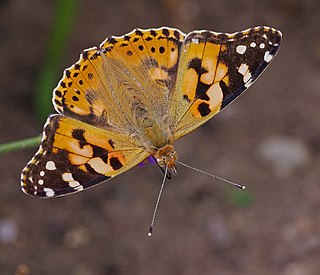
Cynthia is a group of colourful butterfly species that used to be considered a subgenus of the genus Vanessa, in the family Nymphalidae. Before that, it was first described as a genus. Nowadays, this group is not considered a valid taxon anymore, because it is paraphyletic. The name CynthiaFabricius, 1807 is now a junior subjective synonym of VanessaFabricius, 1807.

Eurema hecabe, the common grass yellow, is a small pierid butterfly species found in Asia, Africa and Australia. They are found flying close to the ground and are found in open grass and scrub habitats. It is simply known as "the grass yellow" in parts of its range; the general term otherwise refers to the entire genus Eurema.

Papilio paris, the Paris peacock swallowtail, is a species of swallowtail butterfly found in the Indian subcontinent and southeast Asia.
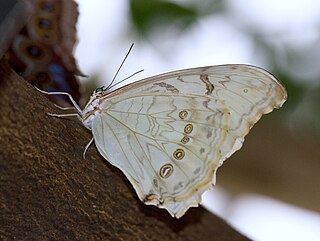
Morpho polyphemus, the white morpho or Polyphemus white morpho, is a white butterfly of Mexico and Central America, ranging as far south as Costa Rica. As suggested by its name, this is one of the relatively few Morphos that is white rather than blue. Some authorities include M. luna, which is also white, as a subspecies of M. polyphemus.

Freyeria trochylus, the grass jewel, is a small butterfly found in Africa, Arabia, southern Europe, India and southern Asia that belongs to the lycaenids or blues family.
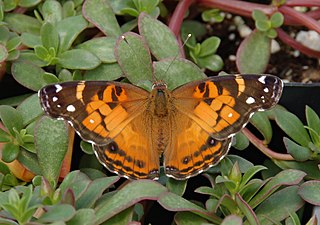
The American painted lady or American lady is a butterfly found throughout North America.

Smerinthus ocellatus, the eyed hawk-moth, is a European moth of the family Sphingidae. The species was first described by Carl Linnaeus in his 1758 10th edition of Systema Naturae.

Plebejus christophi, the small jewel blue, is a small butterfly found in Asia that belongs to the lycaenids or blues family.

Ypthima baldus, the common five-ring, is a species of Satyrinae butterfly found in Asia.

Ypthima huebneri, the common fourring, is a species of Satyrinae butterfly found in Asia.

Ionolyce helicon, the pointed lineblue, or bronze lineblue, is a small butterfly found in the Indomalayan realm that belongs to the lycaenids or blues family.

Erebia ligea, the Arran brown, is a member of the subfamily Satyrinae of the family Nymphalidae. This brown is widespread in south-eastern and northern Europe. It prefers mixed woodlands at low altitudes. It is rarely seen in open areas. This species was first described by Carl Linnaeus in his 1758 10th edition of Systema Naturae, and the type locality is Sweden.

The common wood-nymph is a North American species of butterfly in the family Nymphalidae. It is also known as the wood-nymph, grayling, blue-eyed grayling, and the goggle eye.

Morpho aurora, the Aurora morpho, is a Neotropical butterfly found in Bolivia and Peru.

Papilio thoas, the king swallowtail or Thoas swallowtail, is a butterfly of the family Papilionidae. It is found in the southernmost United States, Mexico, Central America and South America. The species is easily confused with the giant swallowtail, which it closely resembles in both larval and adult stages. The caterpillars feed on the leaves of citrus plants (Rutaceae). They have also been reported as feeding on a member of the genus Piper.
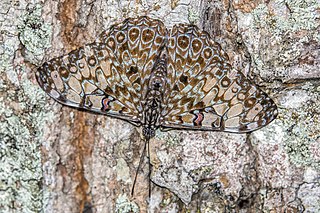
Hamadryas feronia, the blue cracker or variable cracker, is a species of cracker butterfly in the family Nymphalidae. It is found in the southern parts of North America and South America and southwards Brazil.
Ypthima pupillaris, the eyed ringlet, is a butterfly in the family Nymphalidae. It is found in Guinea, Ivory Coast, Ghana, Togo, Nigeria, Cameroon, the Republic of the Congo, the Democratic Republic of the Congo, Sudan, Ethiopia, Uganda, Kenya, Tanzania, Malawi, Zambia, Zimbabwe, and Mozambique. It is allied to doleta - smoke-brown; wings above with the marginal part lighter, proximally bounded by a dark line, with two fine marginal lines; forewing with a large, oval, bi-pupilled eye-spot; hindwing with an eye-spot in cellule 2 and a very small double one in 1 c. Wings beneath grey, densely striated with olive-brown, a submarginal stripe and a marginal line dark. Hindwing beneath with three eye-spots, one with double pupil in 1 c, one in 2 and a larger in 6. Central Africa.

Ypthima striata, the Nilgiri jewel fourring or striated fivering, is a species of Satyrinae butterfly found in south India.
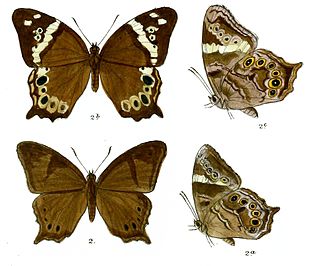
Lethe daretis, the Sri Lanka treebrown, is a butterfly in the family Nymphalidae. It is endemic and restricted to cloud forests of central highlands of Sri Lanka such as Horton Plains.

Lethe dynsate, the Ceylon forester, is a butterfly in the family Nymphalidae. It is endemic to Sri Lanka.


















